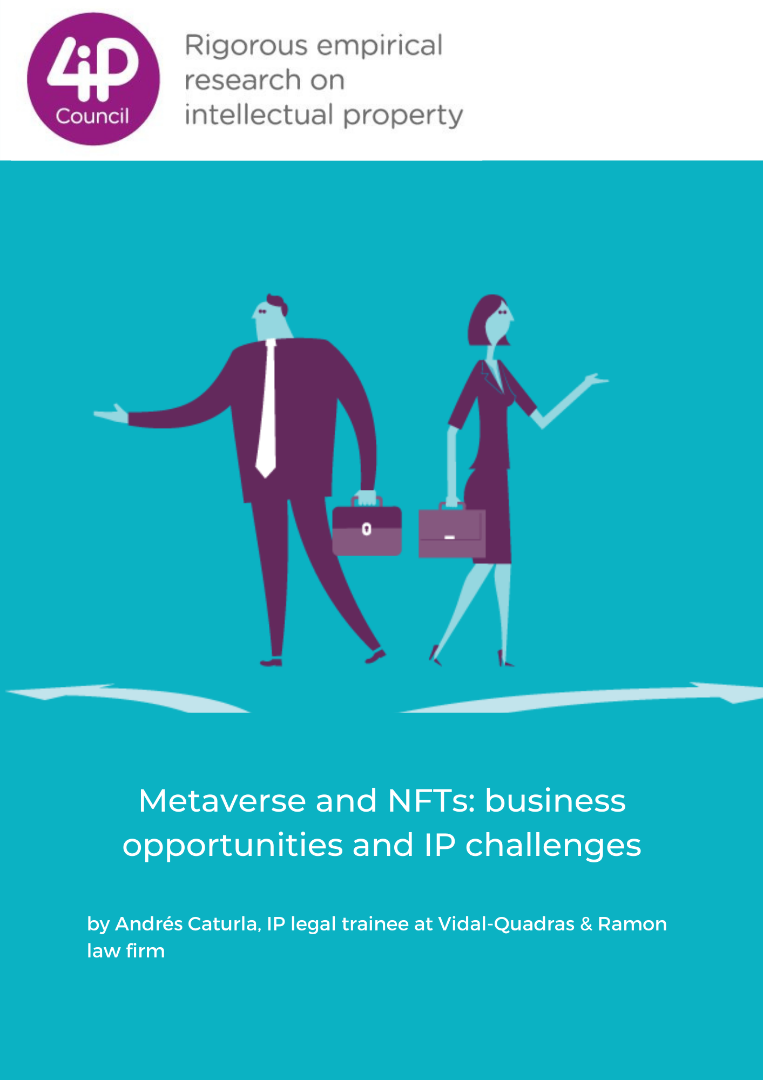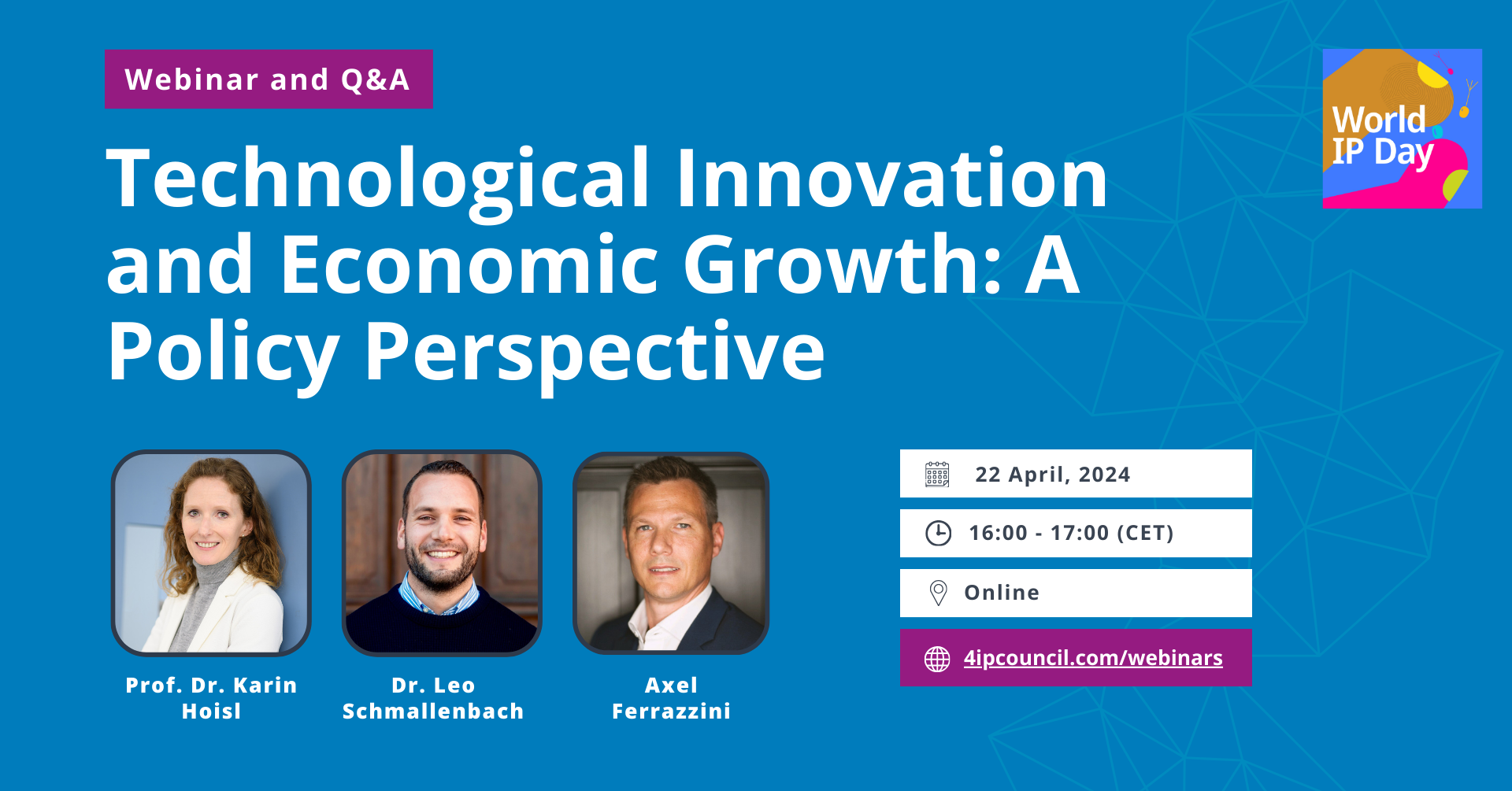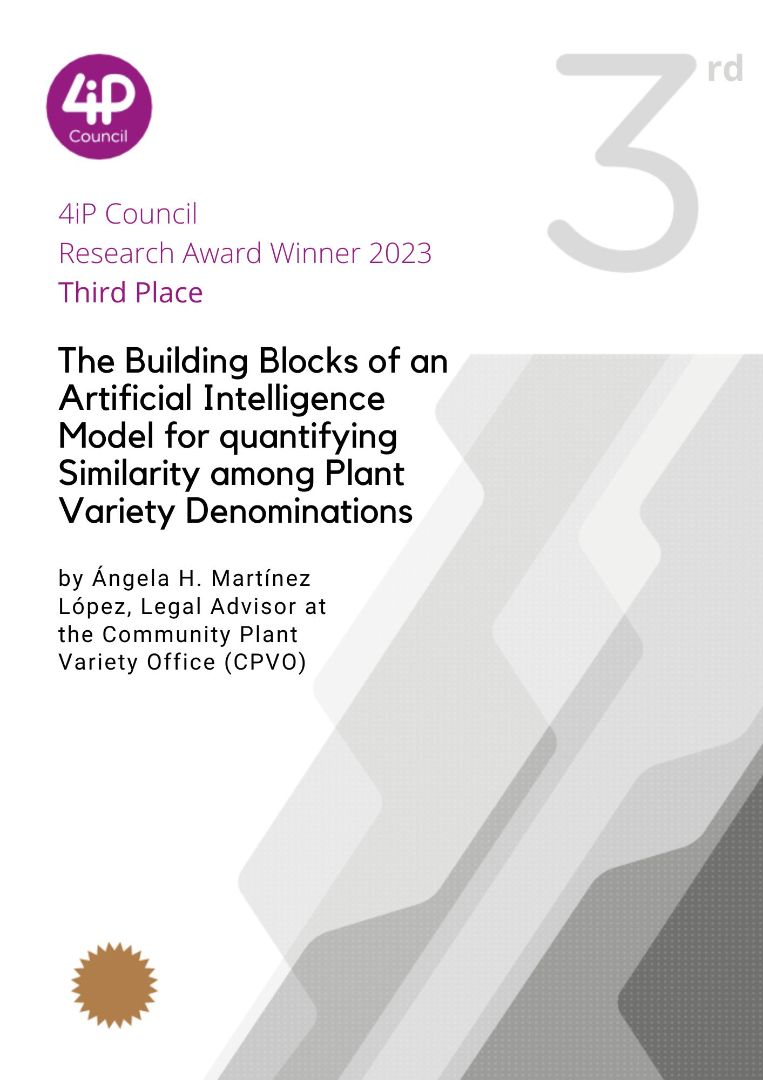Metaverse and NFTs: business opportunities and IP challenges
by Andrés Caturla
1. Introduction
In December 2021, a fragmented artwork by the artist Pak called “The Merge” was sold for $91.8 million, the highest price ever paid for a ‘digital’ piece of art publicly sold by a living artist. The Merge consists in a series of NFTs (non-fungible tokens), which are uniquely identifiable (thus, non-interchangeable) units of data stored on a blockchain.
The possibilities afforded by NFTs are set to be crucial in the evolution of the metaverse by introducing the concept of property in a 3D digital world. NFTs allow new ways of owning and transacting digital goods. Money in the metaverse is represented by cryptocurrencies, that allow users to buy and sell among other things, NFTs.
The metaverse is conceived to be a place “where people can socialise, work and play.” Ultimately, it allows users to merge reality and the virtual world. The high expectations of the metaverse have led to a change of Facebook’s branding to Meta and, more importantly, an expenditure of $10 billion in 2021 by Mark Zuckerberg’s company alone. Other tech giants such as Microsoft or Google are also making big moves towards the development of the metaverse. In January 2022, Microsoft concluded a $70 billion deal to acquire Activision Blizzard, one of the most important video game developers in the world. Google is preparing for the metaverse. The company is further developing its augmented reality technology, and has recently invested nearly $40 million in a private equity fund for its metaverse projects. We may just be witnessing the beginning of the next digital revolution, boosted by the technologies that will shape the metaverse, including NFTs.
Those acquiring NFTs can become owners of the original copy of virtual goods such as virtual paintings, real estate, cars, boats, etc. Thus, NFT owners can sell or trade them. Against this background, questions have been raised regarding the need for intellectual property rights (IPRs) to protect such a ‘property’ in the metaverse.
The present article highlights some of the opportunities the metaverse can provide, as well as some challenges that it may also face. In particular this article focuses on IPRs and their impact on the development of the metaverse.
2. The metaverse and NFTs: new opportunities
Although many may believe the metaverse to be a brand new concept, the idea of interacting with others in a digital world has been around for a while. Some games such as ‘Second Life’, launched in 2003, offer an alternative reality. However, what is special about the metaverse is that, instead of running in parallel, both worlds (virtual and real) are ‘merged’.
NFTs allow users to interact and socialise in the metaverse, by acquiring different kinds of virtual items or attending events of their choice. For example, metaverse real estate has become a trendy commodity for investors, reaching $500 million in sales in 2021, and with estimates of around $1 billion for 2022. Last year, a virtual real estate plot was sold in the form of an NFT in Decentraland, a popular online world, for $2.4 million in cryptocurrency. Another example can be seen in the fashion sector. In 2021, Adidas and Karlie Kloss launched 20 designs as part of their digital fashion collaboration. Those who made the highest bid for each design automatically received an original copy of the artwork through an NFT that certifies their ownership and the uniqueness of the item via blockchain. A blockchain is a shared, immutable database that enables the recording of transactions and tracking of assets in a computer network. Data in a blockchain is stored electronically in digital format. In the entertainment sector, artists such as Travis Scott, Ariana Grande and The Weeknd have already performed massive concerts in the metaverse. Some of the most renowned nightclubs in the world have also announced their plans to open virtual versions of their dancefloors. In that context, NFTs will be used as access passes or tickets to join the party.
3. Intellectual Property challenges
Although the metaverse is set to revolutionise the way we connect with each other, it is still not fully developed as its main proponents envision it. Therefore, questions regarding potential risks and challenges remain. Some of them concern IPRs as a possible way to protect innovation in the metaverse.
a. Copyright
One of the key questions when it comes to NFTs is whether an NFT owner also owns the underlying IPR. Some believe that by buying an NFT of an artwork, one acquires the ownership of the actual piece, with all its accompanying rights. Others disagree, arguing that even though the work of art is needed to create the digital token related to it, they actually have little in common. NFTs are ‘just’ metadata files that contain a digital version of a particular work of art, or any other asset, stored on a blockchain. For example, when “Everydays: The First 5000 Days”, a digital art collection, was sold for $69 million the buyer ‘only’ received a digital copy of it in the form of an NFT. In this case, the copyright over the work underlying the digital token was not included in the auction and still belongs to the artist Mike Winkelmann. However, other artists may attract potential buyers by offering copyright ownership of the artwork, together with the digital copy stored in a blockchain. Ultimately, owning the digital file that tokenises a particular physical asset does not necessarily provide the owner with any property rights over the asset itself.
Similarly, many questions arise on whether the process of minting an NFT can be done based on an artwork protected by copyright. Minting an NFT consists in transforming a digital file of a certain physical asset into a digital asset stored on a blockchain. Thus, any digital file is subject to be converted into an NFT. However, some argue that only the copyright owners should be allowed to create NFTs based on their works, since they bear the exclusive right to reproduce them. In 2021, a federal district court in New York City ruled in favour of Roc-A-Fella Records, copyright owners of Jay-Z’s album “Reasonable Doubt”, prohibiting Damon Dash, one of the co-founders of the label, from independently auctioning an NFT of the album. The reasoning behind the decision was that the copyright belonged to the record label.
Even more controversial are the cases in which an author sells an NFT of their work after transferring some of the IPRs attached to it. In November 2021, the production company Miramax sued Quentin Tarantino in a California federal court to try to prevent him auctioning exclusive scenes from his “Pulp Fiction” script. Miramax argued that selling NFTs does not fall within the limited contract rights that Tarantino holds for the film. While Tarantino argued that NFTs are screenplay publications of an artwork, which he is legally allowed to perform, Miramax argued that an NFT is a one-time transaction that exceeds the filmmaker’s reserved rights. It is expected that the court’s decision will answer some relevant questions on the nature of NFTs and how this relates to copyright law.
b. Trade Marks
As mentioned above, the metaverse is a digital 3D world where people can develop their identities and interact with others. Typically, the representation of such an identity will be an online avatar. Users customise their avatars by buying virtual clothing, eyewear, footwear, sports gear, and other accessories. However, there are some trade mark law implications to be considered in this context. For example, disputes may arise when a virtual good in the metaverse replicates a real good protected by a registered trade mark.
In November 2021, the NFT creator Mason Rothschild was sued in a New York district court by the luxury brand Hermès after launching a collection of “MetaBirkin” NFTs based on the famous Birkin bags. The French brand alleged an excessive use of its Birkin mark that entailed trade mark infringement and injured the brand’s reputation while misleading consumers about the origin of goods sold under the Birkin mark. On the other hand, Rothschild claimed that his creative liberties allow him to create and sell what he considers to be just “a playful abstraction of an existing culture-fashion landmark.” This case will presumably shed some light on the intersection between trade mark law and creative liberty in connection with NFTs.
In February 2022, Nike filed a lawsuit in a district court of New York against StockX, an online marketplace, for launching NFTs based on limited-edition Nike shoes that were accompanied by an image of the sneaker. Nike accused the online resale platform of intentionally confusing consumers, leveraging the brand’s reputation to attract potential buyers. In addition, Nike brought claims of trade mark infringement, false designation of origin, and trade mark dilution, among other infringements. StockX counterargued that there is no trade mark infringement as their Vault NFTs are not virtual or digital sneakers. Rather their NFTs are tokens that can be either traded in their platform or redeemed for a physical pair of the sneakers stored in their vault. One of the most interesting questions the court will assess is whether StockX NFTs are just a representation of the physical asset they tokenise or a separate virtual product, whose commercialisation would infringe trade mark rights.
c. Patents
Innovative technologies are certainly needed for a fast and successful development of the metaverse. Meta’s vision for the virtual world relies heavily on technologies such as Virtual Reality (VR) or Augmented Reality (AR) to help people connect and explore the metaverse. In that regard, patents have a key role to play in incentivising companies to continue R&D efforts that will eventually provide users the best possible experience. This may explain the fact that large companies such as Microsoft, Google, Meta, Apple, and Samsung, were in the top ten of virtual reality patents issued in the third quarter of 2021.
As in any innovation protected by IP, concerns have been raised of virtual reality patent wars. However, disputes over virtual reality technologies are not new, with some cases dating back to the early 2010s. Still these disputes have not hindered innovation in the field. Whether this will apply in the case of the metaverse remains to be seen.
4. IP Strategy in the metaverse
In light of the development of the metaverse, companies should assess whether their current IPRs protect them from an unauthorised use in the virtual world. If so, the benefits of such protection would be twofold: (i) it would prevent or at least discourage infringement from others, such as NFT creators and (ii) it would strategically position IPR holders from the real world in the booming alternate-reality sphere. Should their IPRs not protect them against unauthorised use in the virtual world, a different strategy, such as filing additional IPR applications for the virtual world may be needed.
a. Brand protection and value
When considering IP protection in the metaverse, the first intellectual asset many would think of is trade marks. As more companies invest in the metaverse and start offering digital products, the fraudulent use of trade marks will most likely increase. Selling virtual goods, creating virtual showrooms to connect with customers at a scale never seen before, launching new products or offering virtual training programs are just some of the possibilities the metaverse brings to companies taking part in it. However, without enforceable trade mark protection, such uses cannot be avoided or sanctioned. Lacking trade mark protection, some companies may be reluctant to enter the metaverse, missing out on the opportunity of highly increasing their brand value through exploiting the new virtual worlds.
Companies from various market sectors are already protecting their brand names in the new virtual reality. For example, the retail corporation Walmart has recently filed several trade marks with the intent of manufacturing and selling virtual goods. In the entertainment sector Ticketmaster, one of the world’s largest ticket marketplaces, has partnered with the National Football League to offer some game tickets as NFTs. This comes together with the filing of a trade mark application to cover such online activity as well as those activities which Ticketmaster plans to pursue in the future. In the fashion world, Vanity Fair has filed a trade mark application concerning the transmission of video and audio content through digital networks. Since then, the magazine has been very active in the metaverse, recently launching “MetaVanity.” This project is conceived to be an online exhibition of works from renowned artists of the digital art scene.
Notwithstanding the variety of economic sectors in which companies are preparing for the metaverse, apparel companies are leading the race when it comes to trade marks. Some examples are Converse, Abercrombie & Fitch, Hugo Boss, Gap, Puma, and Nike. In particular, Nike is determined to enforce its position in the metaverse, to the point of making it a priority for the brand. Last year, the multinational company filed seven different “virtual goods” trade mark applications, including “Nike”, and its logos “Just Do It”, “Air Jordan” and “Jumpman.” By using IP, Nike is working to ensure the success of its further ventures in the metaverse, e.g.: selling virtual clothing, headwear, or footwear through NFTs. Up until this point, the Nike metaverse projects can be seen as a success, with the highlight of the virtual store “Nikeland” attracting almost 7 million people from 224 countries.
b. Approaching IPR protection in the metaverse
The most successful business models in the new era of the Internet will most likely be those which take a holistic approach to IP protection. The metaverse is set to revolutionise the way companies do business at almost every level. In such a context, deploying an effective IP strategy may be needed to compete in this new landscape.
Many questions remain to be answered as we approach the next steps of the digital era. For example, some differences may appear between “virtual” and “real” trade marks. There is the possibility that some trade marks end up gaining recognition in the metaverse without protecting any physical asset. Moreover, trade mark franchising, copyright transfer agreements, patent licensing deals and other usual business collaborations involving IPRs may change in nature.
In light of the above, the companies that will likely successfully enter and prevail in the metaverse are those that thoroughly consider every potential protectable aspect of their services and products, and closely monitor related case-law. Also, the metaverse will presumably emphasise the already existent interconnection between IPRs, making virtual goods subject to various types of IP protection at once. For example, the same virtual product may need to be protected by a trade mark, under copyright law, and be covered by a design patent. Therefore, companies should be diligent when considering IP protection to take full advantage of all the new virtual opportunities that are just around the corner.
5. Conclusions
The metaverse, including the technologies that enable it, has an immense potential. The idea of creating virtual worlds where people can socialise, work and play is an attractive one and has already generated huge expectations. However, for this vision to attract businesses around the globe, investment in the metaverse will need to be recovered, potentially thanks to IP protection. In this context, the outcome of some ongoing court decisions will play a key role.
In the meantime, while some companies have chosen to sue those who are using unique digital files (NFTs) of ‘real’ assets protected by IPRs without their authorisation, others have decided to pro-actively file trade marks to protect their brand and e.g., manufacture and sell virtual goods (such as works of art or event tickets), or transmit video and audio content through digital networks.
Both technology developers and business owners entering the metaverse should seek to prevent IP infringement by protecting their intellectual assets. Companies owning traditional IPRs should also be aware of IP lawsuits concerning the metaverse and other possible regulatory updates as we approach the merging of the real and virtual worlds. In this sense, effective IP strategies from private companies as well as from institutional bodies will be key in consolidating the metaverse as a cornerstone of the 4th industrial revolution.
Andrés Caturla is an IP legal trainee at Vidal-Quadras & Ramon law firm. This paper is the result of research conducted at 4iP Council in the author’s previous role as IPR Policy Researcher. The views herein are those of the author and do not necessarily represent the views of Vidal-Quadras & Ramon, 4iP Council or any of its supporters.






